The impact of Medicaid waiver programs on reducing caregiver burden
Supporting Caregivers Through Policy Innovations and Community-Based Care

Understanding Medicaid Waivers and Their Role in Easing Caregiving Burdens
Medicaid waiver programs are vital policy tools that expand access to home and community-based services for vulnerable populations, including the elderly and individuals with disabilities. These programs not only facilitate aging in place and improve health outcomes but also play a crucial role in supporting family caregivers. As caregiving responsibilities grow with demographic shifts, understanding how Medicaid waivers impact these caregivers is essential for informing policy and practice.
What are Medicaid waivers and their significance for states
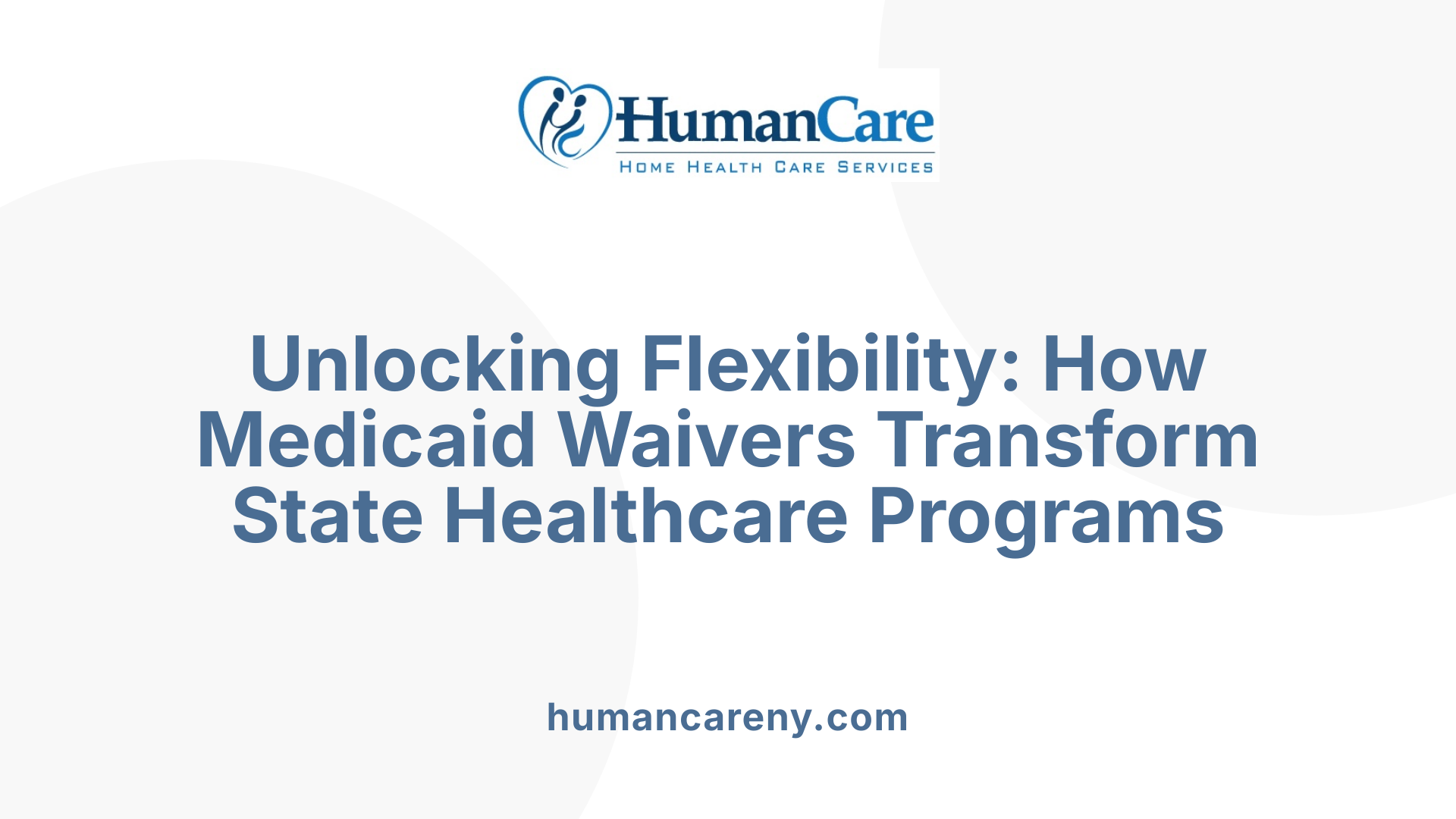
What are Medicaid waivers and why are they important for states?
Medicaid waivers are special approvals granted by the federal government that allow states to modify or bypass certain federal requirements within their Medicaid programs. This flexibility lets states tailor services to better meet their specific needs, especially for populations with unique health challenges.
There are several types of Medicaid waivers, including Section 1115, 1915(b), and 1915(c) waivers. Each serves different purposes:
- Section 1115 waivers are experimental or pilot projects designed to test innovative approaches to Medicaid delivery.
- 1915(b) waivers focus on managed care models, allowing states to restrict provider networks and promote cost-effective service delivery.
- 1915(c) waivers facilitate home and community-based services, helping individuals avoid institutionalization and remain in their communities.
These waivers provide crucial flexibility, fostering innovation in Medicaid programs. States can introduce new models of care, expand coverage to underserved groups, and implement cost-saving strategies while still adhering to federal budget and policy guidelines.
Federal oversight ensures that such programs remain cost-effective and meet quality standards, but states have considerable leeway to customize their offerings.
As a result, Medicaid waivers have transformed access to healthcare by enabling states to develop targeted solutions. They support not only medical services but also social supports, mental health, and long-term care, impacting health outcomes positively.
Every state employs at least one type of Medicaid waiver, reflecting a diverse landscape of approaches. This customization helps address local health priorities effectively.
In summary, Medicaid waivers are essential tools that empower states to innovate and improve their Medicaid programs, ultimately expanding access to care and improving health results for vulnerable populations.
More information
Search query: Medicaid waivers, Section 1915(c), Medicaid policy flexibility
How Medicaid waivers support family caregivers directly

How does a Medicaid waiver work to support family caregivers?
Medicaid waivers are designed to expand access to home and community-based services, allowing family members to play a central role in providing care. These waivers, especially the 1915(c) type, enable caregivers to be directly involved in the health and daily needs of their loved ones.
One significant way they do this is through self-directed care programs. These programs grant caregivers, often family members, the authority to choose the services and providers that best fit their loved ones' needs. Importantly, they also facilitate financial support. Caregivers can receive payments—either hourly wages or per diem rates—for providing personal care, assistance with activities of daily living, or specialized health tasks.
This financial support recognizes unpaid family caregiving as essential work and helps to ease some of the financial burdens associated with ongoing care. It offers a way for family members to be compensated for their critical contributions, encouraging more consistent and professionalized care.
In addition to direct payments, Medicaid waivers provide a range of supportive services to caregivers. These include respite care, which gives caregivers temporary relief from ongoing responsibilities; training programs to enhance their skills; and counseling or support groups to address emotional and psychological needs.
The role of waivers like 1915(c) in caregiver support
The 1915(c) waivers are among the most utilized in delivering flexible, tailored services for specific populations such as older adults and individuals with disabilities. These waivers allow states to tailor services that meet individual needs, including direct caregiver support. Through these waivers, states can fund caregiver training programs, offer financial compensation, and provide access to respite services.
Moreover, some waivers empower caregivers by allowing them to become certified and paid providers, effectively formalizing unpaid roles and integrating them into the healthcare system. This not only boosts caregiver morale but also improves the quality of care by ensuring caregivers have access to proper training and resources.
Formalizing unpaid family caregiving
By enabling financial support and professional training, Medicaid waivers help formalize the work of unpaid family caregivers. This recognition is vital, especially as the demand for in-home care increases with an aging population.
Support programs backed by waivers foster a more sustainable care environment. They enable families to maintain their loved ones at home longer, delay more costly institutional care, and enhance overall health and wellbeing.
| Program Component | Description | Impact |
|---|---|---|
| Self-directed care programs | Caregivers manage care decisions and services, often with financial support | Enhances autonomy and financial stability for caregivers |
| Payments to caregivers | Financial compensation for providing hands-on care | Acknowledges unpaid labor, reduces financial stress |
| Respite care, training, and support services | Resources to help caregivers manage stress and improve skills | Enhances care quality and caregiver wellbeing |
| Role of waivers like 1915(c) | Flexible service models tailored to individual needs | Supports community living and delays institutionalization |
This structured support from Medicaid waivers plays an essential role in empowering family caregivers, acknowledging their contribution, and ensuring care recipients receive high-quality, personalized support in their homes.
Broader health and community outcomes of Medicaid waivers
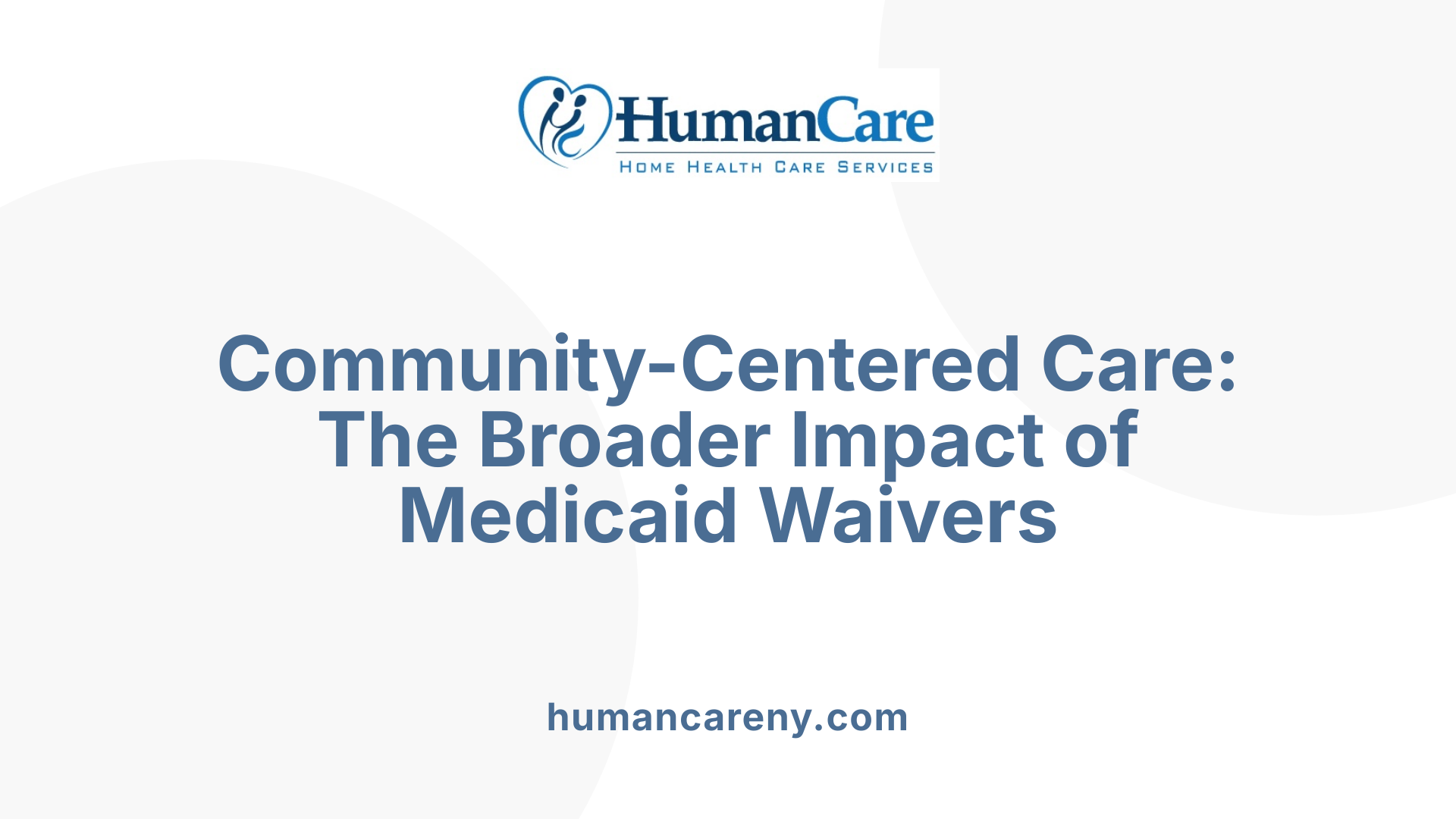
What are the broader health and community-based outcomes associated with Medicaid waivers?
Medicaid waivers, especially the 1915(c) home and community-based services (HCBS) waivers, significantly influence the health and social well-being of their recipients. These programs are designed to extend care beyond traditional institutional settings and promote independence among older adults and individuals with disabilities.
One of the primary benefits of Medicaid waivers is their role in supporting aging in place. By providing tailored services such as personal care, respite, and case management, these programs enhance the ability of individuals to live comfortably and safely at home. This shift toward community-based care aligns with the Olmstead decision, which mandates community integration for people with disabilities.
Research shows that increased waiver spending correlates with notable health improvements. For example, a $1,000 increase in spending per older adult is associated with a 1.4% improvement in self-reported health status, along with reductions in mobility, instrumental activities of daily living (IADL) limitations, and psychological distress. These outcomes demonstrate that more investment in community services can lead to better overall health and reduced reliance on costly institutional care.
In addition, Medicaid waivers foster social inclusion by enabling individuals to participate actively in community life. By offering services in familiar settings, these programs help maintain social connections and community involvement, which are vital for mental and emotional well-being.
Children with disabilities, notably those with autism spectrum disorder (ASD), benefit from expanded access to healthcare through waiver programs. Increased eligibility and service limits have reduced unmet healthcare needs, particularly for children who would otherwise not qualify for Medicaid. This ensures that vulnerable populations receive necessary therapies, medical equipment, and supports to thrive in their communities.
Overall, Medicaid waivers shift the focus from institutionalized care to a more person-centered, community-oriented approach. They improve health outcomes, promote social inclusion, and help families and individuals achieve greater independence, making them a vital component of modern healthcare policy.
Impact of Medicaid waivers on caregiver workload and stress
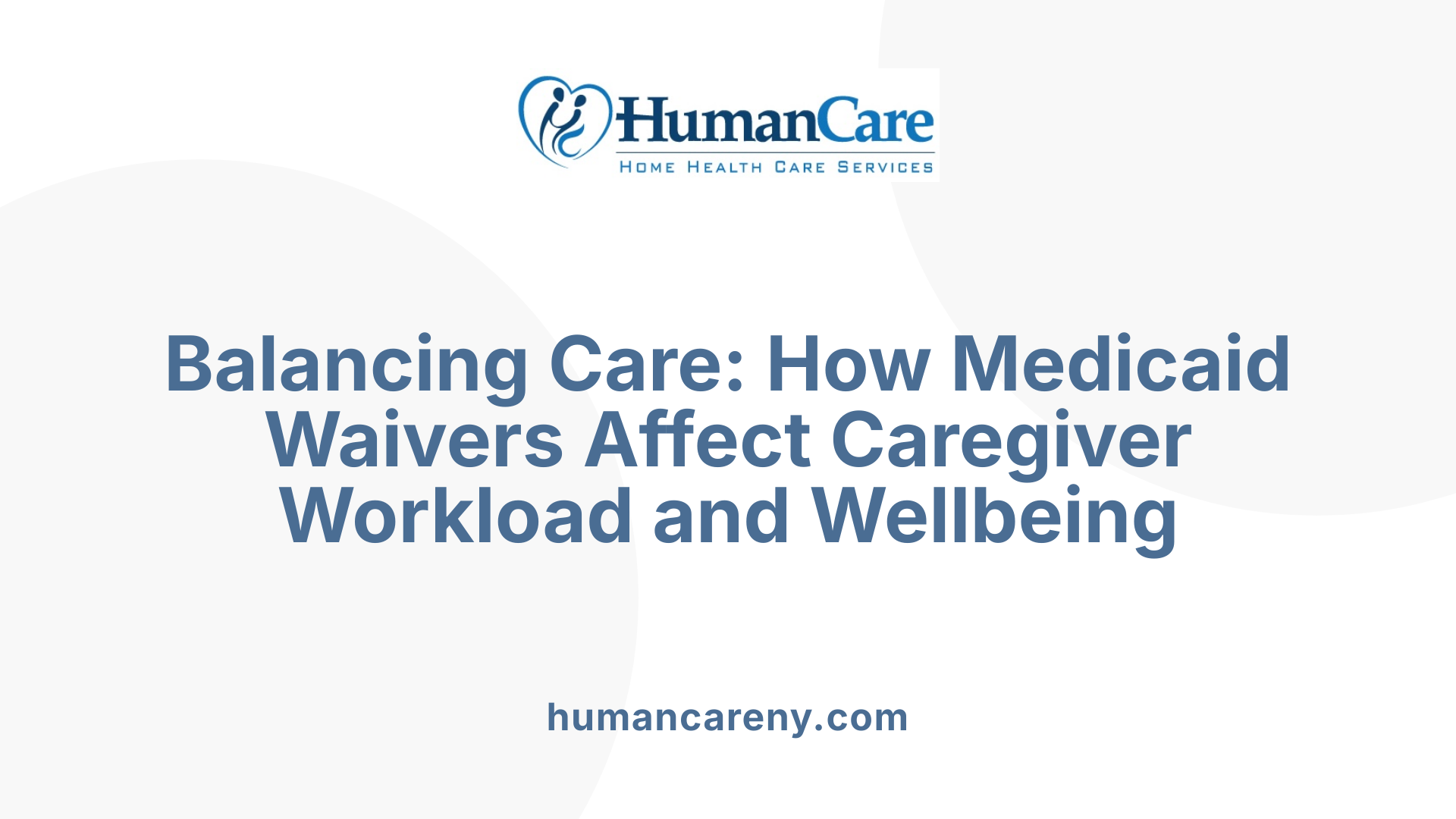
How do Medicaid waiver programs affect caregiver workload and stress?
Medicaid waiver programs play a vital role in supporting family caregivers by offering services and financial assistance aimed at enabling older adults and individuals with disabilities to age in place. These programs provide respite care, caregiver training, and direct payments, which can ease some of the physical and emotional burdens associated with caregiving.
However, the influence on caregiver workload and stress is not entirely straightforward. While supports like respite and training help reduce the intensity of caregiving, they can also introduce new responsibilities. Family members often need to understand complex care plans, coordinate various services, and manage medical and behavioral needs of their loved ones.
Caregivers of individuals with intellectual and developmental disabilities (I/DD) tend to experience moderate stress levels. They frequently face challenges such as administering medications, managing behavioral therapies, and finding paid help. The need to continuously adapt to changing health conditions and navigate eligibility and service options adds to their load.
To address these challenges, thorough caregiver assessments and personalized support strategies are essential. These can help tailor services to fit specific needs, alleviating some of the stress related to uncertainty and overload.
In summary, Medicaid waivers significantly influence caregiver workload and stress, offering valuable support that can ease some burdens while simultaneously increasing responsibilities. A balanced approach focusing on individualized care and support can help mitigate some of the pressures faced by family caregivers.
| Aspect | Effect | Additional Notes |
|---|---|---|
| Respite care | Alleviates stress | Provides family caregivers with a break to rest and recharge |
| Training programs | Reduce uncertainty | Equips caregivers with skills for complex care tasks |
| Care management | Can increase workload | Caregivers often manage multiple services and create care plans |
| Caregiver stress levels | Moderate | Especially notable among caregivers of individuals with I/DD |
| Support strategies | Mitigate stress | Tailored assessments and community resources improve caregiver well-being |
This layered impact underscores the importance of ongoing support and adaptive policies to sustain caregivers' vital role in community-based care.
Effects of Medicaid waivers on informal caregiving patterns

What is the impact of Medicaid waiver programs on informal caregiving patterns?
Medicaid aging waivers play a significant role in shaping how families and individuals approach caregiving at home. Research shows that increasing federal and state funding for these programs leads to a rise in informal caregiving. Specifically, a 10% boost in Medicaid aging waiver expenditures correlates with a 0.1 percentage point increase in the likelihood that an adult child becomes an informal caregiver to her parents. While this percentage may seem modest, it indicates a meaningful shift in caregiving dynamics across the population.
The rise in funding not only promotes the engagement of family members in caregiving roles but also influences the nature and intensity of these responsibilities. The study finds that as waiver funding increases, there is a tendency for less intensive caregiving activities. For example, family members, especially women, are more likely to reduce hours spent on personal care tasks, possibly because the additional support services funded by waivers alleviate some of the physical and emotional burdens.
How does increased waiver expenditure impact caregiving hours and responsibilities?
Enhanced funding allows families to access a variety of support services, such as respite care, training, and home modifications. This, in turn, can help delay or prevent nursing home placements by making it easier for families to care for their loved ones at home. The data suggests that with more financial support, caregivers tend to shift toward providing less intensive assistance, focusing on essential or supplemental care while reducing time spent on personal or medical tasks.
This shift is crucial because it can help prevent burnout among family caregivers and improve overall well-being. It also indicates that increased resources allow for more flexible caregiving roles, which accommodate individual preferences and capabilities.
Are there gender differences in how caregiving responsibilities change?
Interestingly, the study highlights gender differences in response to increased waiver funding. Female caregivers tend to reduce their caregiving for personal care tasks as the funding levels rise. This may reflect societal expectations or caregiving norms, with women possibly reallocating their efforts toward emotional support or more manageable tasks when formal support services are available.
Overall, Medicaid waivers support a more adaptable caregiving environment, helping families tailor care to their needs while alleviating some of the physical demands associated with intensive caregiving. This balance benefits both caregivers and care recipients, promoting aging in place and family stability.
| Aspect | Effect | Additional Details |
|---|---|---|
| Increased likelihood of caregiving | +0.1 percentage points | Slight rise in family members engaging in informal care due to waiver funding increases |
| Change in caregiving intensity | Reduction in hours for personal care | Less physical burden on family caregivers as support services increase |
| Gender-focused effects | Women reduce personal care tasks | Reflects different caregiving roles and societal norms |
| System-wide impact | Promotes aging in place | Supports families in caring at home, delaying institutionalization |
The research underscores that enhanced Medicaid funding for aging and disability waivers fosters a caregiving environment that is more sustainable, flexible, and supportive. It encourages families to stay involved while adapting responsibilities as needed to preserve quality of life for all involved.
Policy implications for supporting family caregivers through Medicaid
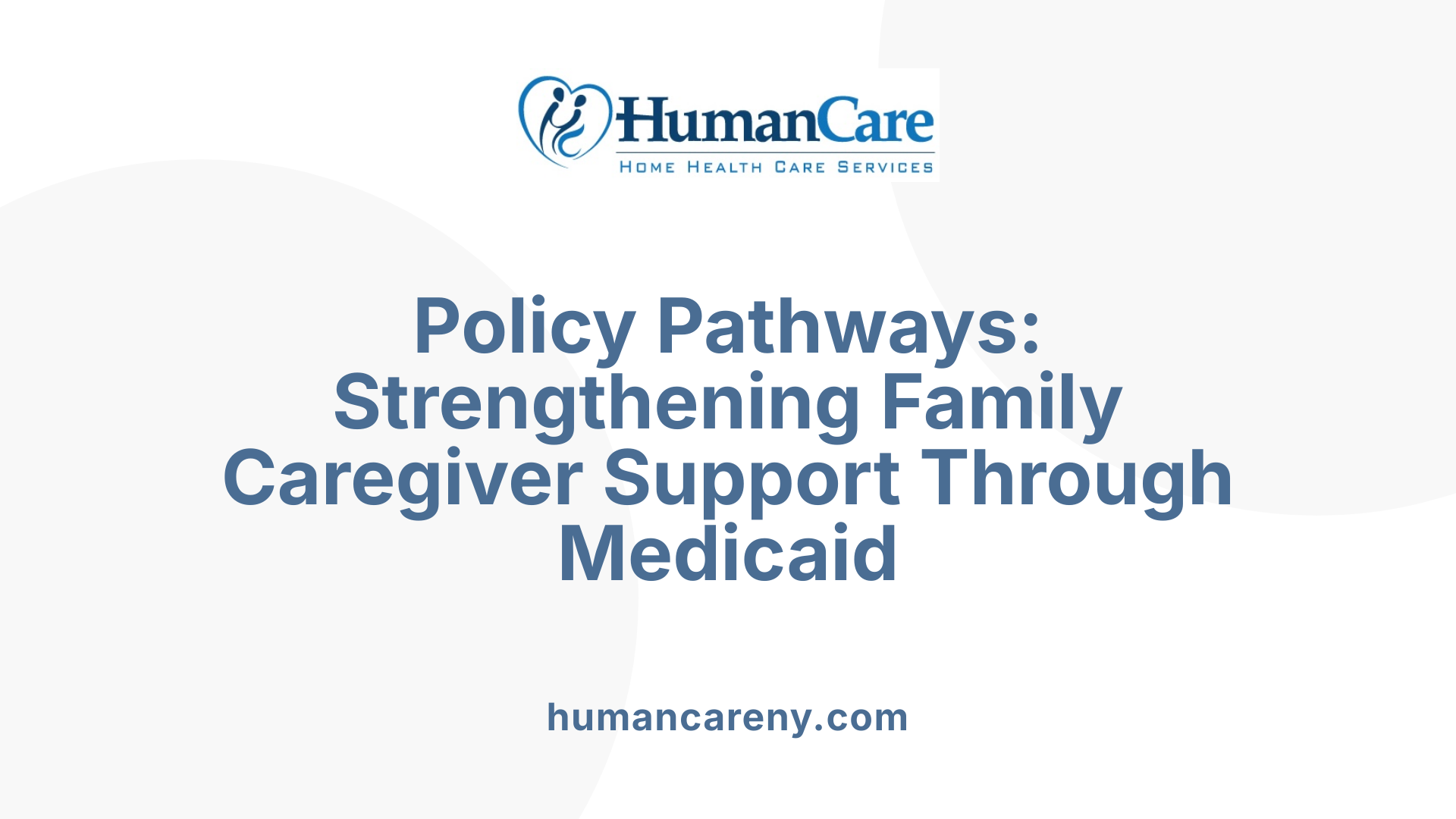
What are the policy implications of Medicaid waiver programs for caregiver support?
Medicaid waiver programs play a crucial role in shaping policies aimed at supporting family caregivers. These programs allow states to expand access to home and community-based services (HCBS), which are vital for enabling older adults and individuals with disabilities to remain in their homes. They fund services like respite care, caregiver training, and financial payments that directly assist family members in providing care.
Most states support family caregivers through Medicaid by enabling self-direction, where caregivers can choose, train, and dismiss care providers, often including family members. Additionally, states offer payments and training tailored to specific needs, such as caregiving for Alzheimer’s or developmental disabilities.
These policies promote community-based care, with the added benefit of delaying costly institutionalization. As a result, policymakers are encouraged to protect and expand these supports, recognizing caregiving as an essential role. This is especially important amid demographic shifts, where the aging population increases demand for family caregiving.
However, there are concerns. Future funding cuts or the imposition of work requirements could threaten these services. They may increase family caregivers’ burden and lead to more reliance on expensive institutional care. Ensuring sustained and flexible Medicaid funding helps maintain the vital support systems that benefit both caregivers and care recipients.
In conclusion, Medicaid waiver programs are not just healthcare policies—they are foundational in supporting the informal workforce that forms the backbone of long-term care in the U.S. Protecting and expanding these programs remains a strategic priority to meet the growing needs of aging Americans.
Unmet healthcare needs among children with disabilities
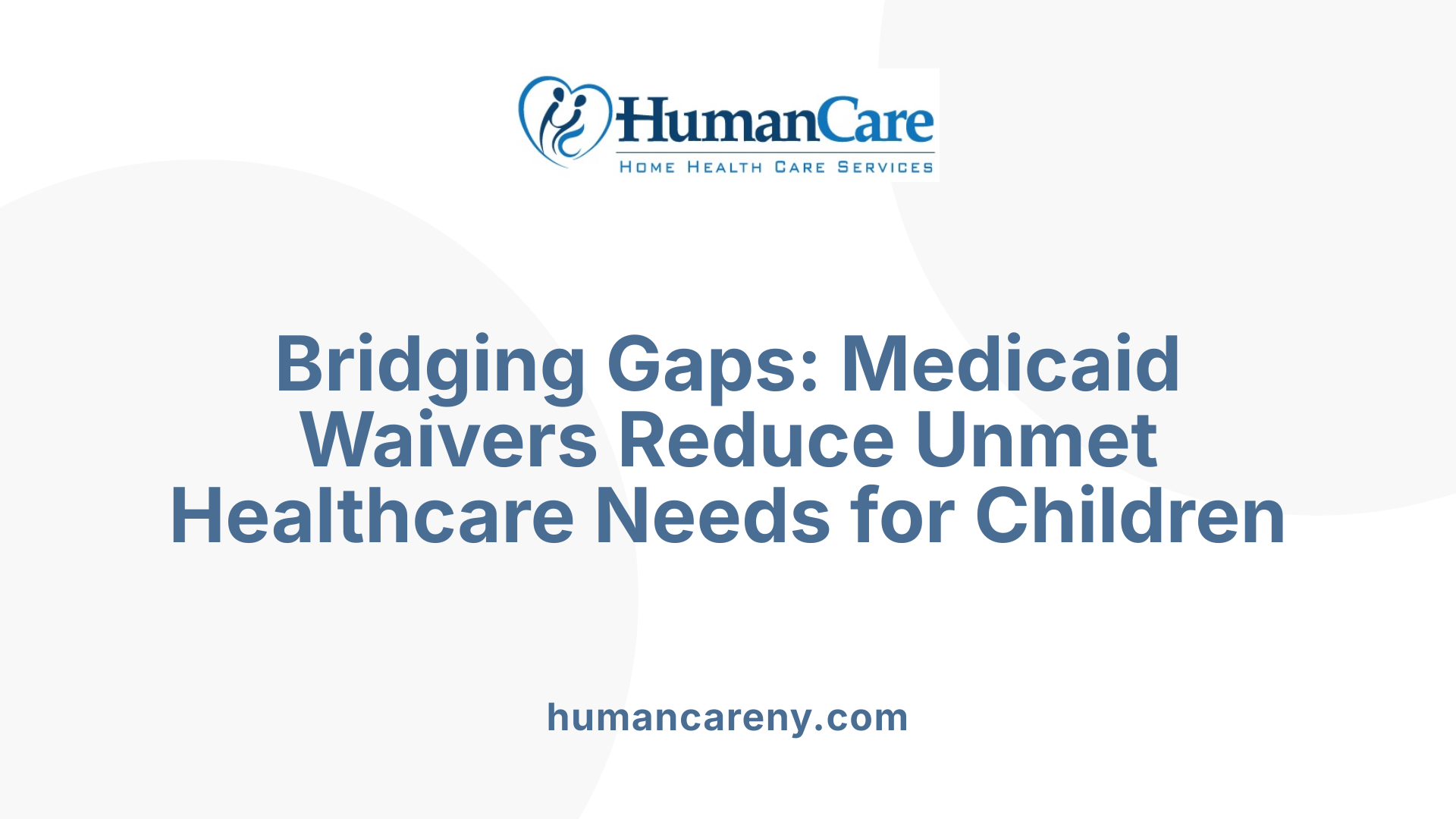 Medicaid HCBS waivers play a crucial role in reducing unmet healthcare needs among children with disabilities, including those diagnosed with Autism Spectrum Disorder (ASD). By expanding eligibility and providing tailored services such as therapies, behavioral interventions, and specialized equipment, these waivers help families access essential healthcare that would otherwise be unavailable or limited.
Medicaid HCBS waivers play a crucial role in reducing unmet healthcare needs among children with disabilities, including those diagnosed with Autism Spectrum Disorder (ASD). By expanding eligibility and providing tailored services such as therapies, behavioral interventions, and specialized equipment, these waivers help families access essential healthcare that would otherwise be unavailable or limited.
Features like higher enrollment limits, increased state funding, and higher cost caps per child are associated with more significant improvements in meeting healthcare needs. Studies show that states with greater waiver flexibility and resources report fewer unmet needs, particularly benefiting children from higher-income households who can more easily navigate the complex application processes. Despite these advances, barriers remain—long waitlists, eligibility restrictions, and disparities across states limit access, often leaving vulnerable populations underserved.
In particular, children with ASD benefit substantially from Medicaid waivers. These programs help fill gaps in service provision, enabling children to receive therapies at home and participate in community activities, which enhances social inclusion and health outcomes. However, racial and socioeconomic disparities persist, with minoritized groups and lower-income families facing higher barriers to enrollment.
Across states, variability in program design and funding levels influences the extent of unmet needs reduction. Higher-income households tend to report better access, partly due to resources that facilitate application and navigation of services. Conversely, underserved communities often face challenges such as limited awareness and complex eligibility requirements.
Overall, Medicaid waivers are pivotal in supporting community-based care for children with disabilities. They help diminish unmet healthcare needs and improve quality of life, but ongoing policy efforts are necessary to address existing disparities and ensure equitable access to these vital services.
Temporary policy changes and their implications during COVID-19

How did policy changes during the COVID-19 pandemic affect caregiver support?
The COVID-19 pandemic prompted a series of rapid policy innovations under the umbrella of public health emergency (PHE) authorities. Federal and state agencies took steps to significantly bolster support for family caregivers through Medicaid home and community-based services (HCBS). One of the most notable measures was enabling states to support and pay family caregivers, which helped address workforce shortages and eased caregiver burden during a critical time.
Most states leveraged PHE authorities to expand access to services, increase provider payments, and enhance caregiver support through various programs. These measures included direct payments to family caregivers for personal care, respite care options to give caregivers necessary breaks, and additional training to equip caregivers with essential skills. These steps provided crucial relief and helped maintain continuity of care amid rising risks of institutionalization.
Expansion of services and payments
During the pandemic, many states extended Medicaid-funded caregiver payments and broadened service offerings. Payments often targeted those caring for individuals with intellectual or developmental disabilities and older adults with physical disabilities. Respite programs and caregiver training were also expanded, providing vital emotional and practical support. These efforts aimed to improve caregiver well-being, delay institutional stays, and promote aging in place.
Transition away from emergency policies
As the public health emergency declaration expires, many of these temporary policies are being phased out. Several states are ending or restricting caregiver payments, reducing access to respite care, and scaling back expanded services. For example, some temporary waiver provisions that allowed for paid family caregiving are being withdrawn, reverting to pre-pandemic protocols. This rollback could undermine the progress made in supporting family caregivers, particularly by increasing their workload and stress levels.
Potential risks of policy rollbacks
The impending discontinuation of pandemic-era policies poses several risks. Caregivers may face increased physical and emotional strain, potentially leading to higher rates of burnout. Reduced access to respite and training programs could result in poorer health outcomes for care recipients and possibly more emergency hospitalizations or premature institutionalization.
Furthermore, rollback of these policies risks widening existing disparities, as marginalized groups, including racial and ethnic minorities, may experience barriers in accessing renewed or continued support. To sustain the gains achieved during the pandemic, policymakers must consider the importance of supporting and maintaining flexible, responsive caregiver programs.
In summary, while the emergency measures during COVID-19 played a critical role in supporting family caregivers and maintaining community-based care, their gradual removal may threaten to reverse these positive developments. Policymakers need to evaluate the long-term implications and design strategies to embed successful practices into regular Medicaid policy frameworks.
The future outlook: policy and demographic trends affecting caregiver support

Aging Population and Increased Demand
The American population is aging rapidly, with projections indicating a significant rise in the number of older adults requiring long-term care. As the older population grows, so does the need for supportive services that allow seniors to age in place. Medicaid’s home-and-community-based services (HCBS) and waivers play a critical role by providing funding for services that help older adults stay at home rather than moving into nursing facilities. This shift toward community-based care aligns with the preferences of many seniors and their families.
Technological Innovations to Support Independence
Advances in technology are transforming caregiving methods. Remote patient monitoring, smart home devices, and telehealth services are increasingly integrated into Medicaid HCBS programs. These innovations help maintain independence for older adults and individuals with disabilities, reduce the need for in-person visits, and support caregivers. Technology also enables better communication among care teams and provides data that can improve care plans.
Workforce Shortages and Workforce Solutions
A major challenge confronting Medicaid-funded home and community-based services is the shortage of available caregivers. The COVID-19 pandemic exacerbated these workforce issues, leading to increased strain on families and formal care providers. States are exploring solutions such as expanding paid family caregiver programs, waiving scope of practice laws to enable family members to provide skilled health activities, and offering specialized training. These measures aim to bolster the workforce and ensure that care needs are met.
Policy Advocacy and Federal Support
Federal policies are increasingly recognizing the importance of supporting family caregivers and expanding community-based services. States receive support and guidance from the federal government to develop innovative care strategies, including promoting self-directed care and caregiver training programs. The federal government also advocates for data collection on caregiver demographics and contributions to better tailor policies that meet caregivers’ needs. Efforts during the COVID-19 pandemic, such as providing Medicaid payments to family caregivers, highlighted the potential for policy to alleviate caregiver burdens.
Addressing Disparities in Access and Enrollment
Despite expansion efforts, disparities in access to Medicaid HCBS and waiver programs persist. Racial and ethnic minorities, including Black and Hispanic populations, are less likely to enroll in these services, partly due to socioeconomic barriers and systemic inequities. Targeted policy approaches are needed to improve outreach, simplify enrollment processes, and ensure equitable access. Addressing these disparities will be crucial to providing quality care and support for all individuals, regardless of background.
| Factor | Impact | Strategies |
|---|---|---|
| Aging population | Increased demand for community care | Expand Medicaid HCBS funding, promote aging in place |
| Technology | Supports independence, reduces caregiver burden | Implement remote monitoring, telehealth |
| Workforce shortages | Risks of unmet care needs | Caregiver training, scope expansion |
| Policy support | Enhances caregiver programs | Federal guidance, caregiver payment policies |
| Disparities | Unequal access to services | Outreach, policy reforms targeting minorities |
As the landscape evolves, Medicaid services will likely become more flexible, technology-enabled, and inclusive, ensuring that caregivers and older adults are better supported in the future.
Conclusion: the path forward for caregiver support through Medicaid

How does Medicaid support caregivers and reduce their burden?
Medicaid plays a vital role in easing caregiving burdens by providing support services and financial assistance to family caregivers. Through home and community-based services (HCBS) and waivers like the §1915(c) programs, Medicaid enables many older and disabled adults to remain at home, postponing or avoiding costly nursing facility placements. These programs also support family caregivers with training, respite care, and sometimes direct payments, which help manage the physical, emotional, and financial strains associated with caregiving.
Why is protecting and expanding Medicaid policies important?
Recent research underscores that increased spending on Medicaid aging waivers correlates with greater caregiver involvement, especially for less intensive care activities. Preservation and expansion of these policies are crucial to sustain and enhance the existing support system. They help families manage complex care needs and prevent unnecessary institutionalizations, reducing long-term healthcare costs and improving quality of life.
How are innovative and community-based strategies integrated?
States are experimenting with flexible approaches, such as enabling family members to be paid for skilled health activities, offering behavioral health services tailored for caregivers, and adapting care models to individual needs. These innovations, including waivers that waiver scope of practice laws, expand access and improve the quality and sustainability of community-based care. Additionally, technological advancements like remote monitoring support independence and reduce caregiver workload.
What about disparities and equity in caregiver support?
Despite progress, disparities persist. Data reveal racial and ethnic gaps in enrollment and access to Medicaid HCBS, with minoritized populations less likely to receive these services. To foster equity, policies must address these gaps—ensuring fair access, culturally competent services, and targeted outreach for underserved groups. Expanding inclusive programs will help ensure all caregivers and care recipients receive adequate support.
What are policy recommendations for a sustainable future?
Moving forward, policymakers should prioritize expanding community-based care options, supporting self-directed services, and recognizing caregiving as an essential role deserving of support and compensation. Long-term solutions include ensuring protections amid changing policy landscapes, embracing technological innovations, and addressing workforce shortages by providing fair wages and training. Transitioning pandemic-era policies into permanent frameworks will be crucial to maintain momentum and uphold caregiver well-being.
By strengthening Medicaid's commitment to community-based, innovative, and equitable care, we can build a resilient support system that empowers families, improves health outcomes, and ensures a sustainable future for long-term care.
Building a resilient, caregiver-centered system
Medicaid waiver programs are instrumental in easing caregiver burden by expanding access to community-based services, enabling self-directed care, and providing financial and emotional support to families. As demographic trends point to increasing caregiving demands, sustained policy efforts and innovative strategies are crucial for maintaining and strengthening these support systems. Protecting and expanding Medicaid waivers can ensure that caregivers are recognized and supported as vital contributors to our healthcare system, ultimately fostering healthier, more inclusive communities.
References
- The Unintended Effect of Medicaid Aging Waivers on Informal Care ...
- the role of medicaid aging waiver program on U.S. older adults - PMC
- [PDF] Policy Brief: The Role of Medicaid in Supporting Family Caregivers
- Medicaid Supports for Family Caregivers - NASHP
- Medicaid long‐term services and supports and caregiving needs of ...
- The Effects of Medicaid Home and Community-Based Services ...
- Inequities in medicaid home- and community-based services waiver ...
- Pandemic-Era Changes to Medicaid Home- and Community-Based ...



































































































